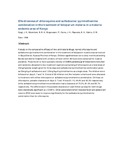Browsing Faculty of Health Sciences (FHS) by Subject "Malaria"
Now showing items 1-8 of 8
-
Coma scales for children with severe falciparum malaria
(Department of Medicine. College of Health Sciences. University of Nairobi, 1997-03)The Blantyre coma scale (BCS) is used to assess children with severe falciparum malaria, particularly as a criterion for cerebral malaria, but it has not been formally validated. We compared the BCS to the Adelaide coma ... -
Effectiveness of chloroquine and sulfadoxine/pyrimethamine combination in the treatment of falciparum malaria in a malaria endemic area of Kenya
(Division of Vector Borne Diseases, Ministry of Health, P.O. Box 20750, Nairobi, KENYADepartment of Medical Microbiology, Faculty of Medicine, University of Nairobi, Box 19676, Nairobi, KENYADanish Bilharziasis Laboratory, Jaegersborg Alle ID, 2920 Charlottenlund, DANEMARKDepartment of Zoology, Kenyatta University, P.O. Box 43844, Nairobi, KENYA, 1998)A study on the comparative efficacy of two antimalarial drugs, namely chloroquine and sulfadoxine/pyrimethamine combination in the treatment of falciparum malaria was carried out in Siaya District, Nyanza Province of Kenya. ... -
Few Plasmodium falciparum merozoite ligand and erythrocyte receptor pairs show evidence of balancing selection
(Elsevier, 2019-04)Erythrocyte surface proteins have been identified as receptors of Plasmodium falciparum merozoite proteins. The ligand-receptor interactions enable the parasite to invade human erythrocytes, initiating the clinical symptoms ... -
A global network for investigating the genomic epidemiology of malaria
(School of Medicine, University of Nairobi, 2008-12-11)Large-scale studies of genomic variation could assist efforts to eliminate malaria. But there are scientific, ethical and practical challenges to carrying out such studies in developing countries, where the burden of disease ... -
Indigenous Knowledge and folk use of a polyherbal antimalarial by the Bayang Community, South West Region of Cameroon
(Department of Pharmacology and Pharmacognosy, 2012)Nefang is a polyherbal preparation constituted of the leavesof six plants and the bark of one of these,used traditionally for the treatment of malaria by the Bayang community, South West Region of Cameroon. Since ... -
Interactions between malaria and HIV infection—an emerging public health problem?
(Department of Medical Microbiology annexe, University of NairobiMRC Human Immunology Unit, Weatherall Institute of Molecular Medicine, John Radcliffe Hospital, 2002-10)Recent evidence demonstrates interactions between malaria and HIV infection. HIV-infected people are more likely to experience clinical malaria, and acute malaria can up-regulate HIV replication, leading to higher plasma ... -
Role of shops and shopkeepers in malaria control.
(1996)A study was carried out to determine the range of antimalarial drugs stocked and also to determine the knowledge and practice patterns of shopkeepers and their customers on antimalarial products stocked and bought. It was ... -
Why has the dihydrofolate reductase 164 mutation not consistently been found in Africa yet?
(Department of Pharmaceutics and Pharmacy Practice, 2005)Resistance to the antifolate sulfadoxine–pyrimethamine (SP), the current mass-treatment antimalarial drug, is associated with selection of point mutations in dihydrofolate reductase and dihydropteroate synthase. Among these ...








